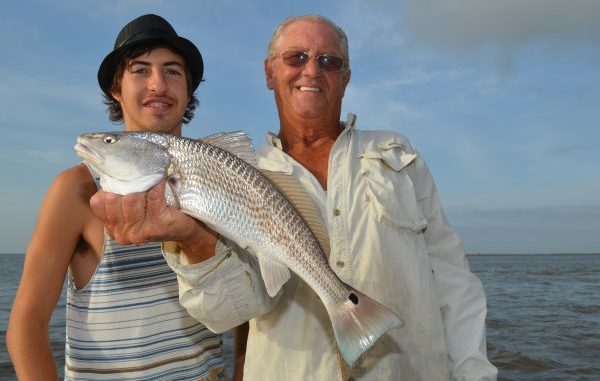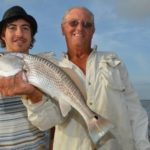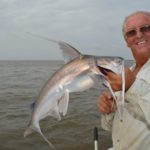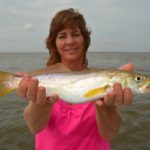
Trout are the stars of the Lake Pontchartrain show, but there are still plenty of fish to catch as summer moves toward fall and trophy specks get harder to come by. It’s just a matter of shifting expectations.
Sometimes people forget that Lake Pontchartrain is about more than speckled trout.
The huge brackish-water lake against which New Orleans nestles has become famous as a top trout destination, and is one of the four top spots that produce trophy trout. (The others are Calcasieu-Sabine lakes, Venice and Vermilion Bay-offshore Marsh Island.)
Most of these lunker Pontchartrain trout are caught at two times of the year: April to mid-June and from early to mid-October through December.
The fishery is simple in strategy, but difficult in tactics. You simply dredge soft-plastic artificials on jigheads on the bottom near the pilings (locally called poles) of the lake’s bridges.
The difficult parts are determining how fish are holding on the poles that day and feeling a bite when it comes.
From late December to March, the lake is certainly a difficult case, some call it a lost cause — time to go duck hunting.
But what about July, August and September?
“Oh, it’s good,” said charter guide Kenneth “Kenny” Kreeger (Lake Pontchartrain Charters, 985-643-2944).
And he should know; he has been a guide on the big lake for 13 years, and has fished it for 55 years.
When Kreeger said it’s good, he meant that it’s still good for speckled trout fishing — but it’s an even better place from which to bring home a mess of good-eating fish of many species.
Kreeger set out to put together just such a mixed box on a recent charter trip. On board were Anita Wilkinson, a vivacious brunette from Boerne, Texas, and her 19-year-old son Forrest. The Wilkinsons were fishing as part of a party of five, the other three of whom were with charter Capt. John Haller of 1 Chasing Tails Charters.
Kreeger ran his boat from Rigolets Marina eastward down Rigolets Pass to a rusty iron railroad bridge that spanned the pass immediately before it opened into Lake Borgne. He swung the big bay boat toward the eastern end of the bridge, near where the iron trussed span of the bridge met the untrussed part.
Three boats were already tied up there. One was Haller’s. Kreeger eased the boat up under the bridge and quickly ran to the bow to toss his bow rope over a beam under the bridge.
That done, he explained to his customers what was happening while he rigged their rods.
“Fishermen call this bridge the L&N Bridge, but it is really the CSX Bridge,” he said. “It is only good on a falling tide, and only the first four or five boats here will catch fish.”
Farther out on the bridge, more toward the center of the pass, water currents are too strong to fish. Farther in toward the bank, currents might not be strong enough.
He added that he felt more fish are on the eastern end of the bridge because bait species seem to follow the eastern shoreline of the pass.
And, Kreeger said, near the end of the falling tide, when currents slacked off, fishing along the wooden fenders of the bridge’s draw in the center of the pass would be good, especially for black drum.
But at that point, the tide was far too strong to attempt fishing there.
He raked some live shrimp out of the baitwell, baited the Wilkinsons hooks and instructed them to cast from the stern of the boat downcurrent, away from the bridge.
The shrimp were large — easy to picture battered and fried.
“For some reason,” Kreeger explained, “at this bridge, the bigger the shrimp are the better.”
He put his shrimp on the hook differently than most other live-bait anglers: He drove the point of the hook up through the bottom of the first segment of the tail and curled it forward, but not far enough for the point to show.
“They stay alive a lot longer hooked that way,” Kreeger explained, “and with the barb of the hook buried in the tail, they stay on the hook better.”
The peace of the bridge was only interrupted by the occasional train rumbling over it. It was too peaceful; none of the four boats were picking up any fish.
The current was really ripping.
His brow furrowed, Kreeger studied the water.
“The fish are here; I’m sure,” the captain said. “With the strong tide, the fish are just moving and not stopping to feed.”
His favorite tidal ranges are from 0.6 to 1 foot. This day’s range was 1.1 feet — not really that bad.
But another environmental factor was exacerbating the situation.
“The west wind that we have been having is pushing a lot of water out of the lake, and that’s what is making the strong current,” Kreeger concluded.
He mumbled something about moving the boat down the bridge to get slightly nearer the shoreline, where the current might be less fierce. As if reading Kreeger’s mind, one of the other boats did that very thing.
The first cast from that boat after it settled into its new spot yielded a hefty specked trout.
“Alright, reel them in,” he commanded, as he moved to the bow to untie the boat.
At the next spot, Kreeger had no overhead iron to tie off to, so he looped his bow rope around one of the concrete poles that support the bridge.
The water was much shallower here — 10 feet deep instead 25 feet. In the new spot, as in the old, Kreeger constantly coached his customers to pick up their bait from the bottom by lifting their rod and dropping it.
“It’s very important to jump the bait up and set it down,” he counseled. “If you just let it sit, the bait will hide itself in the bottom. If you wait, a fish will eventually get it, but you get a lot more bites by moving it.”
In this fishing, patience is a virtue once a trout sucks in the shrimp.
“When you first feel a bite, don’t strike,” he intoned. “Kind of lean back on the line and wait for the fish to make a commitment. Speckled trout, especially, will take the time to fold up the shrimp to avoid its horn before swallowing it.”
“These are pretty smart fish,” Anita Wilkinson said.
Kreeger’s reply was a knowing grin.
The move paid off immediately when Forrest wrestled in a decent redfish. The two men grinned broadly as they posed the fish for the camera.
“Lake Pontchartrain is known for more than its trout,” Kreeger explained to his customers. “It has a lot of big drum, big sheepshead and from mid-October to the end of November, it has big flounder.”
He paused to unhook two nice speckled trout in quick succession for Forrest and a white trout for Anita, and then continued.
“Also, a few redfish, white trout, occasional nice croakers and channel mullet sometimes (can be caught),” Kreeger said. “And, of course, specks are always a featured species.”
Kreeger explained that the Pontchartrain mix-up actually goes from June through November, but that a lot more trout are in the catch during October and November.
April and May are considered strictly trout months in the lake.
The morning went quickly as it got hotter. About half the fish that came over the rail were speckled trout, the rest were a mixture of sheepshead, white trout, channel mullet, redfish and even a couple of good-sized gaftopsail catfish that were kept for filleting.
Only black drum eluded the trio.
Kreeger finished the morning by moving the boat to the western fender of the bridge’s draw. The wooden fender served both as a shield to block any air movement from the boat and as a heat reflector.
Fishing nearly straight down in the 25 foot deep water, the crew caught a few more speckled trout before Anita Wilkinson decided to call it a day.
As the two Wilkinsons grabbed bottles of cold water, Kreeger said anglers who give up after the glory months of trophy trout are making huge mistakes.
“A lot of people slow down fishing once the glamour of catching specks on artificials is off,” he said. “They are missing a good time: Just wear sun screen and long-sleeved white clothes.”


